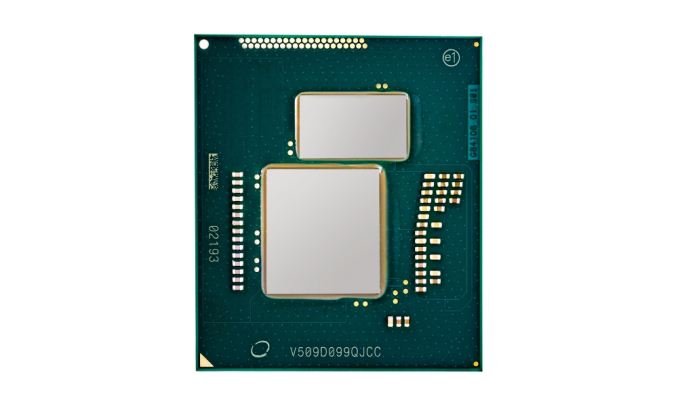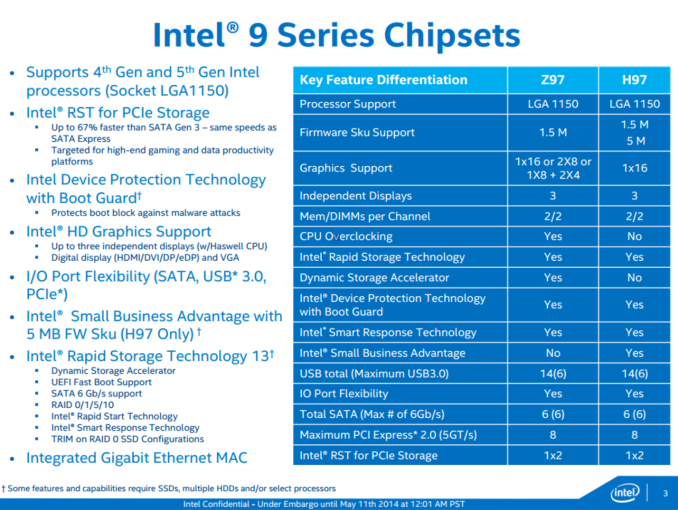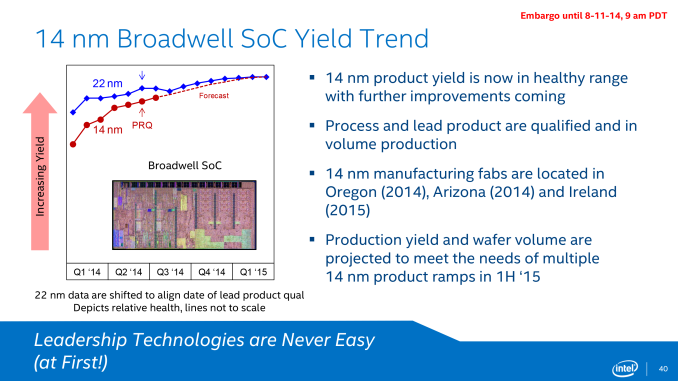The Intel Broadwell Desktop Review: Core i7-5775C and Core i5-5675C Tested (Part 1)
by Ian Cutress on June 2, 2015 7:45 AM ESTThe SKUs
While today's release doesn't preclude Intel from releasing additional Broadwell-DT processors in the future, for now here is what the starting lineup of five 65W SKUs looks like.
| Intel 65W Broadwell-DT Lineup | |||||
| i7-5775C | i7-5775R | i5-5675C | i5-5675R | i5-5575R | |
| Price | $366 | $348 | $276 | $265 | $244 |
| Cores | 4 | 4 | 4 | 4 | 4 |
| Threads | 8 | 8 | 4 | 4 | 4 |
| Base CPU Freq. | 3.3GHz | 3.3GHz | 3.1GHZ | 3.1GHZ | 2.8GHZ |
| Turbo CPU Freq. | 3.7GHz | 3.8GHz | 3.6GHz | 3.6GHz | 3.3GHz |
| Graphics | Iris Pro 6200 (GT3e) | Iris Pro 6200 (GT3e) | Iris Pro 6200 (GT3e) | Iris Pro 6200 (GT3e) | Iris Pro 6200 (GT3e) |
| EUs | 48 | 48 | 48 | 48 | 48 |
| iGPU Freq. | 1150MHz | 1150MHz | 1100MHz | 1100MHz | 1050MHz |
| TDP | 65W | 65W | 65W | 65W | 65W |
| DRAM Freq. (DDR3L) |
1600MHz | 1600MHz | 1600MHz | 1600MHz | 1600MHz |
| L3 Cache | 6MB | 6MB | 4MB | 4MB | 4MB |
| L4 Cache | 128MB (Crystal Well) | 128MB (Crystal Well) | 128MB (Crystal Well) | 128MB (Crystal Well) | 128MB (Crystal Well) |
| Interface | LGA | BGA | LGA | BGA | BGA |
Those with R at the end will be soldered down BGA parts, similar to the mobile Haswell-H models featuring Crystal Well. The two ‘C’ models will be socketed LGA parts, meaning that with a BIOS upgrade should be compatible in all Z87 and Z97 motherboards.
As for pricing, Intel's prices are fairly consistent with what they have been charging over the Haswell generation. The top-tier i7-5775C will fetch $366, a bit over the list price of the i7-4790K, but only about $10 off of the list price of the top Haswell Crystal Well part, i7-4770R. Otherwise the soldered counterpart to the i7 family, the i7-5775R, will go for a bit less at $348.
Below that we have the i5 family. The socketed i5-5675C will go for $276, which happens to be the same list price as the Crystal Well equipped i5-4670R, or $34 more than i5-4670K. Below that we have the last two soldered parts, the $265 i5-5675R, and the $244 i5-5575R.
Ultiamtely it goes without saying that none of these processors will be especially cheap, however with 128MB of eDRAM on-board we weren't necessarily expecting them to be, either. However what this also means is that Intel might take the iGPU crown from AMD, but it will come at nearly 3x the cost.
Broadwell-K, or is it Broadwell-C, or Broadwell-H?
In recent generations, Intel’s overclocking processors have all been given the K designation except the Pentium G3258 which is a special edition model celebrating Pentium’s 20th birthday (but affectionately called Pentium-K). Naturally then we assumed that even though we knew there would be Broadwell processors with Crystal Well, that any overclockable SKUs would be given the K name. But this is not the case, and as a result we have to deal with another identifier in Intel’s product stack. Thankfully, C for Crystal Well is somewhat obvious, although it avoids the overclocking element.
Intel’s other Crystal Well parts, those on Haswell that are for laptops and the three others in todays launch, are all called R. We’re still not sure why they are called R, but now we have Crystal Well with R and C. Something tells me that it might have been easier to call the socketed ones i7-RK, but would you believe it Intel is already using RK for its Atom x3 chip agreement with Rockchip. That leaves i7-CK as a potential, although many users will still call them Broadwell-K, just for ease of use. Intel internally wants to differentiate the K product line from the Crystal Well products, although adding overclocking to the new socketed processors confuses that mix.
Chipset Compatibility
The Broadwell processors will use the LGA1150 socket, which is currently found on all 8-series and 9-series chipsets. Based on our own internal testing, users should wait until a BIOS for their motherboard is available that officially supports the new processors. In our testing, putting in the CPU without the BIOS caused random freezing and the integrated graphics to fail on simple things such as navigating Chrome. It is also worth mentioning that early BIOSes might not allow overclocking, and this is primarily the reason why we are saving overclocking for another review.
On that note, motherboard manufacturers will typically put out a press release when a new CPU arrives to announce support on at least their major motherboards. Normally this press release appears before the official launch. That being said, similar to the Devil’s Canyon launch, we expect CPUs to be available towards the end of the month at the earliest, rather than on the shelves today.
The Reality
When I read about some of Intel’s plans with Broadwell-DT, I was confused. We are so used to having two sets of processors launched per socket with Intel, covering the complete range from Celerons at the bottom up to i7-K models at the top. Not having a wide range of processors this time will raise question marks, especially for those that want to upgrade to a Broadwell CPU. But I have sat for a while and racked my brains. This is what I have come with.
We all recognize that Intel’s 14nm process was late in getting acceptable yields and is also quite expensive in its own right. To that end, Intel started with the small dies before it moved up to the bigger quad-core ones for desktop and mobile, which given the prevelence of quad-cores in desktop SKUs (virtually the entire i5 and i7 ranges) delayed the desktop release even further. There has been much speculation as to when Skylake will come to market, as if I recall correctly Intel wants to keep to Moore’s Law as much as possible, and that means releasing Skylake at some point in 2015.
To that end, Broadwell-DT is a stop-gap to Skylake. In a stop-gap, you do not release a whole stack, because you end up annoying those who invest and then realise the next thing is just about to be released. So you have to release something interesting that will get interest or target a non-regular crowd. That crowd, by virtue of my comments earlier up the page, is those interested in integrated graphics and Crystal Well. Stick in some eDRAM, make it overclockable, and if you can take the integrated graphics crown from AMD, even better. Users who want peak integrated performance will invest, those wanting peak anything else will buy the greatest which might afford more profit or at least keep the investors happy. It also means that there will not be a massive amount of stock in the channel, so once the stop-gap's replacement is here, the stop-gap can quickly be shifted to End-Of-Life (EOL).
Did that make sense? The comment about EOL is an interesting one, as I have heard rumors from other technology media that they are expecting Broadwell-DT to be put into EOL relatively quickly. However, we can’t confirm this.
The Purpose of This Review
We were able to source both the i7-5775C and the i5-5675C to test, along with a reasonably updated BIOS but right around the time Computex was about to start. A combination of time and firmware means that this review will focus on stock performance, comparing it to other processors in its price range. We also had initial issues with testing the graphics, and due to time constraints again we only have IGP results for the i5, but also we only have Linux tests for the i7. But aside from that we were able to test both CPUs in our regular testing suite and have almost 200 data points between the two for comparison. One of my personal focal points was to retest the Crystal Well implementation for CPU performance, but this time we also get to test it with discrete graphics cards as well.













196 Comments
View All Comments
iTon - Saturday, June 6, 2015 - link
i've think AMD products best when used Mantle API. it can boost up to 30% than DirectX API. Otherwise 10% parts of AMD APU had TrueAudio DSP Processor. so it is not 100% CPU and GPUOxford Guy - Saturday, June 6, 2015 - link
Six APUs and not one FX chip in the charts.LAME
Oxford Guy - Saturday, June 6, 2015 - link
Heaven forbid someone might see that you can get a better Cinebench multithread score from a $100 8320E than from a pricey Intel...Oxford Guy - Saturday, June 6, 2015 - link
8320E with 1600 8-8-8-24 RAM at 1585 due to FSB, Cinebench 15 multithreadone core per module, 4.28 GHz, 399
one core per module, 5.02 GHz, 467
3.33 GHz, 540
one module disabled, 5 GHz, 590
3.8 GHz, 608
Intel i7-3770, 3.4 GHz, 662
4.17 GHz, 664
4.2 GHz, 675
4.28 GHz, 683
4.41 GHz, 703
4.56 GHz, 724
4.68 GHz, 743
4.78 GHz, 765
Intel 4770K at 4.4 GHz, 822
Clearly, an overclocked Intel will beat this chip in this test but if you have an Intel that can't be overclocked that may be a different story, depending on the stock clockspeed of the chip. Also, Cinebench is, as far as I know, a test that favors Intel since it relies heavily on FPU. None of the APUs are close to FX's performance so the lack of even one 8 thread FX in the charts is not good.
The single thread performance of FX is particularly weak but it can be improved quite a bit by setting the chip to 1 core per module because high clocks can be achieved with much less heat than when the full 8 threads are enabled. The downside is that multithread performance suffers (in tests like Cinebench that can use all 8 threads... perhaps not so much in programs that max out around 4).
single thread
A10-7850K, 92
4.2 GHz, 99
A10-6800K, 100
4.78 GHz, 111
5 GHz, 118
5.02 GHz, (one core per module), 120
5.21 GHz (only one module enabled), 122
5.17 GHz (one core per module), 122
Intel i7 3770, 3.4 GHz, 138
Intel i7 3930K, 3.3 GHz, 148
Oxford Guy - Saturday, June 6, 2015 - link
highest scoring APU in the multithread test:A10-6800K, 325
sireangelus - Saturday, June 6, 2015 - link
Anand, i'm going to heavly critizice your linux testing method.you go to great lengths to adjust and compensate for turbo modes, but on an ubuntu 11.04 it should completely ignore turbo modes since sandy bridge or does not even know what turbAdvances in the linux kernelo modes are, severely limiting both new intel and amd cpu. Also, the power profile is changed alongside the new intel pstate driver, that greatly improved performance under linux in respect to the past; also, new kernels are optimized for the eDram on the crystal well cpus. I suggest you start moving the whole testing platform to something more current or simply redo tests once a year with an updated kernel. You could use the phoromatic platform to automatize the procedure.
Ramon Zarat - Sunday, June 7, 2015 - link
Please add clock for clock comparison with older Intel CPU! Back to at least Sandy Bridge or even further if possible.ES_Revenge - Sunday, June 7, 2015 - link
So clearly Intel has now topped AMD's one remaining trump card--integrated graphics performance. Of course you're paying over 2x the cost for the privilege. One might argue that you're still getting a much better CPU at the same time, which is true, but most people just look at the absolute cost and the fact that the A10 is not all that bad a CPU.I think this becomes *much* more interesting if/when Intel starts producing *i3* CPUs with Iris Pro. Then it's really game over for AMD, unless Zen is something spectacular to allow them to catch up (or even get close) in CPU performance. AMD could also easily up the SPs in their APUs to something like ~1024 which would give them R7 265/PS4/GTX 750 Ti -class performance. The only problem is AMD hits another hitch there as they don't have the thermal/power envelope to do so given A10s can already throttle the CPU side when the GPU is in heavy use, in order to stay within TDP limits. AMD's lack of power and thermal efficiency with their GPUs (as competent as they are otherwise) also poses a serious problem in putting the same tech on an APU die.
Seems like AMD has to hit a homerun with both Zen for performance and their GPUs for efficiency in the coming year. However from everything we know about Fiji and the fact that the rest of the [GPU] lineup will be re-brands, it doesn't seem likely. Perhaps it's time to quit the CPU business, lol. Either that or release APUs with high-end graphics, boxed with CLC/AIO liquid coolers (or massive air coolers).
0ldman79 - Sunday, June 7, 2015 - link
I know it's a dead socket, but could we AM3+ users request a CPU be thrown in the mix?I keep reading, keep looking, the reviews look impressive, so I check the Anandtech Bench and my 6300 is still faster than the APU's.
In all honesty, that has to hurt AMD. Those of us that went with the "big boy socket" are still faster overall even though the APU has made big leaps in IPC and clock speed.
Fact is we're still out here and the only way to get faster across the board is to jump Intel.
ES_Revenge - Monday, June 8, 2015 - link
Well keep in mind your FX 6300 has two more cores (or one more module) and it has 8MB L3 compared to no L3 at all on the APUs. If they made a "6 core" APU with L3 on Kaveri/Godavari it would be faster.. at least until it starts hitting the TDP limits, lol. This of course is probably why there are no 6 or 8 CPU-core APUs--because they're already having problems with keeping TDP within limits with a 512SP GPU and 4-core CPU.